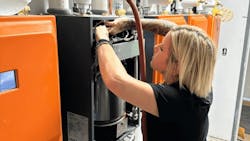How to Save CapEx and OpEx With Proper Water Heater Sizing
Industry professionals agree that anyone can size a hot water heater that supplies adequate hot water to serve building needs and to provide redundancy. However, it takes an expert to specify a system that provides adequate hot water while also minimizing energy usage, capital expense and space needs.
To ensure their posteriors are covered, many plumbing engineers specify commercial water heaters using sizing methodologies that draw on conservative overestimation rather than real world data. In many cases, an additional system is added to achieve “N+1” redundancy, further increasing the capacity of the system. While this approach provides a nearly foolproof backup if one system fails, it is tremendously inefficient in seven areas:
1. Higher Initial Capital Expense: Traditional sizing methods provide commercial buildings with far more capacity than what is needed to meet their demand and achieve redundancy. This unnecessarily increases upfront costs and begins a cascading effect that increases spending on water heating equipment over the lifetime of the units.
2. Greater Fuel Consumption: Water heaters operate most efficiently at close to their rated capacity. Oversized systems operate well below full capacity, resulting in equipment operating less efficiently, increasing energy use and emitting more CO2.
3. Potential for Single Point-of-Failure: Most commercial water heaters have the potential to be taken completely offline when a single failure point is triggered in the system (e.g. leaking storage tank). This potential for a complete failure is why many engineers specify a full duplicate system as back-up.
4. Higher Maintenance Expenses: Oversizing of water heaters and storage tanks requires additional maintenance work and cost.
5. Greater Space Needs: Multiple units require a significant amount of space. Alternatively, this space could be repurposed into revenue-producing space or serve other essential functions within the commercial facility.
6. Wear and Tear/Reduced Equipment Life: One might assume that oversizing a hot water system would reduce wear and tear, extending the system’s life. But oversized systems with low turn-down rates will have more short-cycle firings, increasing wear and tear.
7. Legionella Safety: Legionella thrives in stratified water tanks with slow-moving water that is teeming with microbial nutrients. When systems are doubled for redundancy, water flow is further reduced, providing a more attractive home for bacteria.
To eliminate this wasteful oversizing of water heater systems, forward-thinking engineers should consider several approaches to selecting a safe, properly sized and efficient system:
Specify equipment that minimizes the risk of single point failure. Look for water heaters using redundant heat engines that are independently controlled and self-isolate when mechanical failures occur. Eliminating the potential for single point failure eliminates the need for a full redundant system.
Integrate real-world data into your sizing models. Monitors, sensors and AI learning can all play a role in this, including:
- Look to similar properties in similar climates for guidance. For instance, if you’re specifying a system for a 150-room hotel in Dallas, analyze the needs for a previously specified like-sized hotel in Atlanta.
- Install real-time monitors on the system you are replacing to determine peak times and volumes.
- Tankless units are inherently safer than tanked systems in providing bacteria-free water. They also virtually eliminate all standby losses, as they do not store hot water.
- Systems with higher turndown will save energy and maintenance expenses.
- Look to manufacturers who guarantee the accuracy of their sizing models.
In applying these approaches, engineers can eliminate inefficiencies and specify systems that cost less to purchase, operate and maintain vs. traditionally sized tanked systems.
About the Author
Robbie Svidron
Robbie Svidron serves as Intellihot’s corporate trainer, bringing his field knowledge and expertise of water heating options to contractors and engineers across the country, ensuring that they benefit from the latest advancements in the field.
